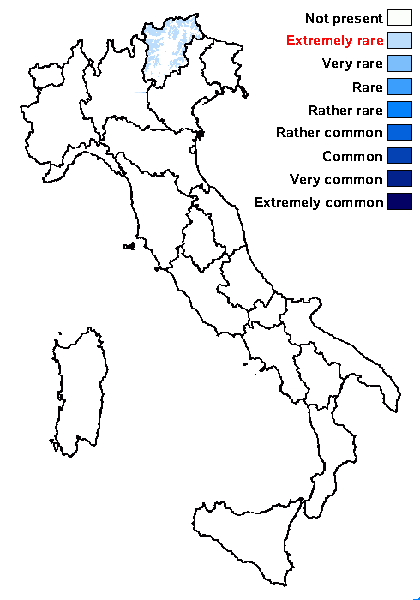Miriquidica disjecta (Nyl.) Hertel & Rambold
Mitt. bot. Staatss. München, 23: 384, 1987. Basionym: Lecidea disjecta Nyl. - Flora, 64: 184, 1881.
Synonyms:
Distribution: N - TAA (Nascimbene & al. 2022).
Description: Thallus crustose, episubstratic, white, areolate, sometimes delimited by a dark prothallus. Medulla white, I-. Apothecia lecideine, black, sessile and constricted at base, with a flat to convex disc and a thin, finally excluded proper margin. Proper exciple brownish in outer part, paler within, the outer hyphae to 6 μm thick; epithecium olive-green; hymenium colourless, c. 60 μm high, I+ blue; paraphyses coherent, the apical cell up to 4 μm wide; hypothecium colourless. Asci 8-spored, clavate, approaching the Lecanora-type, but with a weakly amyloid tholus, lacking an amyloid zone above the axial body and with a thin outer amyloid wall layer. Ascospores 1-celled, hyaline, ellipsoid, 8-11 x 4.5-6 μm. Photobiont chlorococcoid. Spot tests: thallus and medulla K-, C-, KC-, P-. Chemistry: miriquidic acid. Note: the type material of this poorly known saxicolous species was collected on porphyric rocks near Paneveggio.
Growth form: Crustose
Substrata: rocks
Photobiont: green algae other than Trentepohlia
Reproductive strategy: mainly sexual
Poorly known taxon in need of further study
Commonnes-rarity: (info)
Alpine belt: extremely rare
Subalpine belt: extremely rare
Oromediterranean belt: absent
Montane belt: absent
Submediterranean belt: absent
Padanian area: absent
Humid submediterranean belt: absent
Humid mediterranean belt: absent
Dry mediterranean belt: absent

Predictive model
Growth form: Crustose
Substrata: rocks
Photobiont: green algae other than Trentepohlia
Reproductive strategy: mainly sexual
Poorly known taxon in need of further study
Commonnes-rarity: (info)
Alpine belt: extremely rare
Subalpine belt: extremely rare
Oromediterranean belt: absent
Montane belt: absent
Submediterranean belt: absent
Padanian area: absent
Humid submediterranean belt: absent
Humid mediterranean belt: absent
Dry mediterranean belt: absent

Predictive model
 INDEX FUNGORUM
INDEX FUNGORUM
 GBIF
GBIF
 DOLICHENS
DOLICHENS

